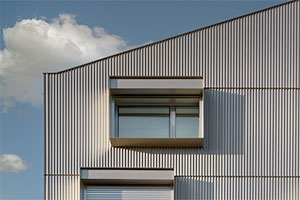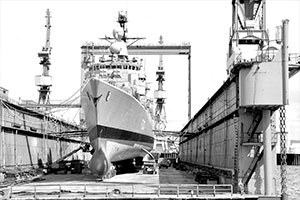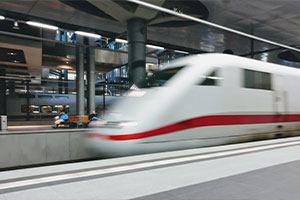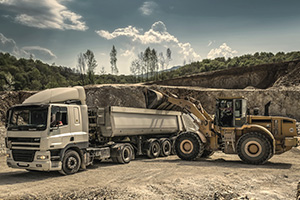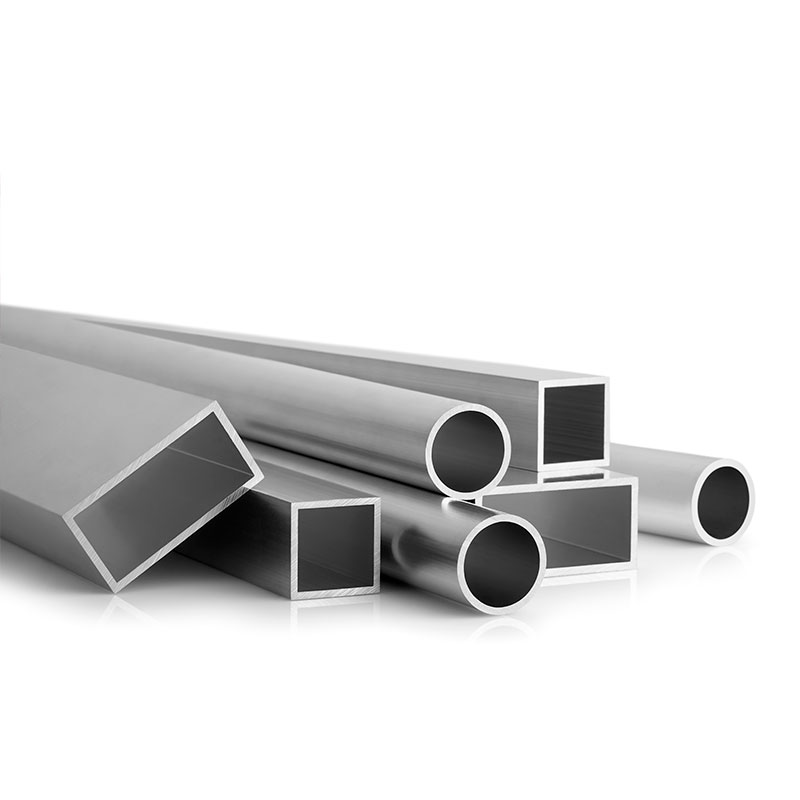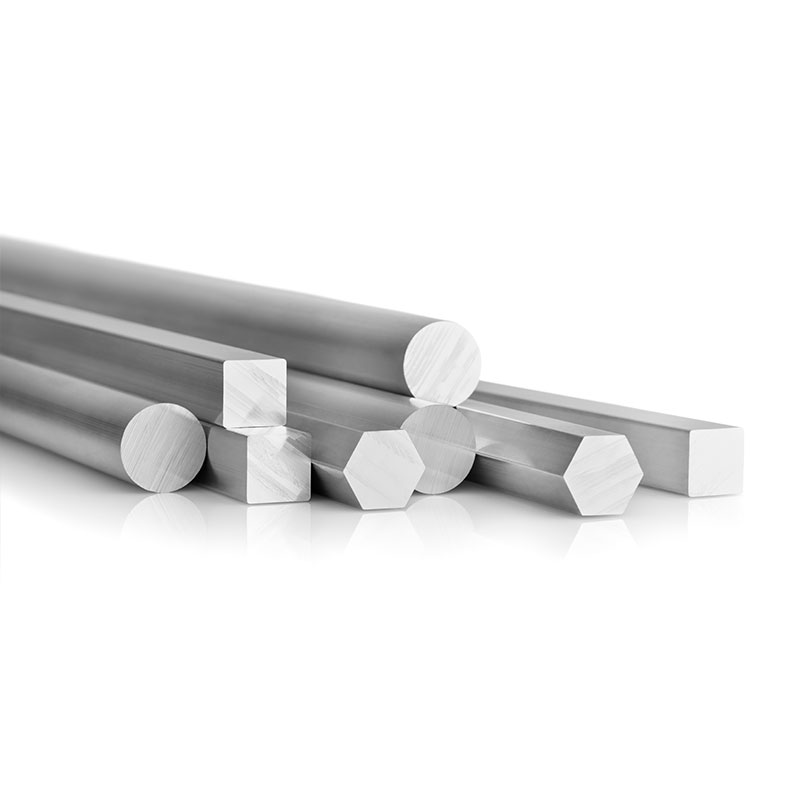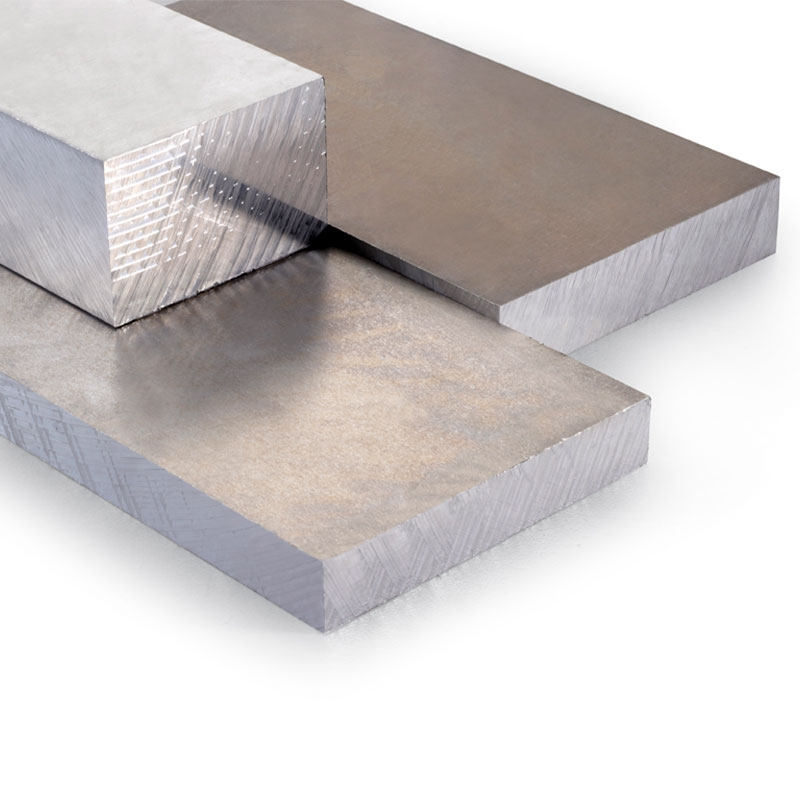
Aluminium products
Standard profiles
We have an extensive catalogue of Standard profiles with more than 600 references in stock. In addition, our extensive knowledge of the sector allows us to supply countless other references on request.
The material usually in stock is extruded from 6060 T66 or 6082 T6 alloy in lengths of 6,050 mm and in rough finish. On request we can supply profiles in other alloys, as well as other lengths or finishes, both anodised and lacquered.
We have a precision cut-to-size service which enables us to provide profiles to the final size required by the customer. We also offer the possibility of supplying the final machined part.
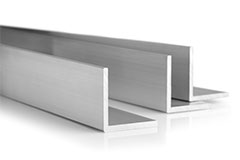
Selection of equal-sided aluminium angles. Profiles in EN AW 6060 alloy is T66 and in 6082 is T6.See our selection of standard aluminium profiles here.
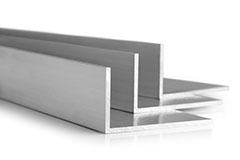
Selection of unequal sided aluminium angles. Unequal-sided aluminium angles. Profiles in EN AW 6060 alloy is T66 and in 6082 is T6.See our selection of standard aluminium profiles here.
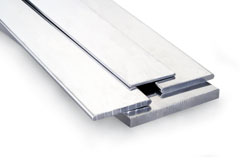
Aluminium sills in different sizes and thicknesses. We supply in EN AW 6060 alloy is T66 and in 6082 is T6.See our selection of aluminium standard profiles here.
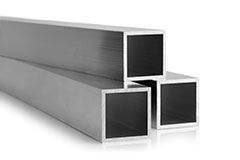
Selection of aluminium square tubes in different sizes and thicknesses.See our selection of aluminium standard profiles here.
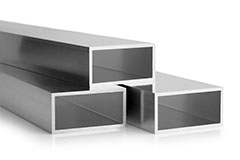
Selection of rectangular aluminium tubes in different sizes and thicknesses.See our selection of aluminium standard profiles here.
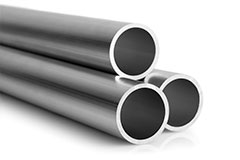
Selection of round aluminium tubes in different sizes and thicknesses See our selection of aluminium standard profiles here.
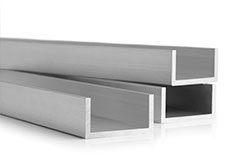
The "U" profile selection for aluminium alloy EN AW 6060 is T66 and for 6082 it is T6.See our selection of standard aluminium profiles here.

See our selection of standard aluminium profiles here.
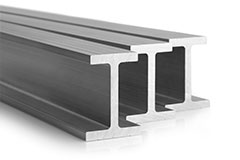
Selection of aluminium double "T" profiles in EN AW 6060 alloy is T66 and in 6082 is T6. See our selection of standard aluminium profiles here.
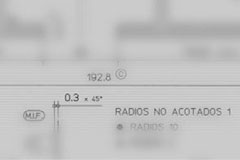
We have the capability to develop custom aluminium profiles to customer design. Please contact our team. See our selection of standard aluminium profiles here.
Aluminium Bars
Aluminium bars are a forged product generally produced by extrusion. They are semi-finished products mainly used in machining processes to obtain all types of parts for a wide range of industrial sectors.
Main alloys
The end use of the product to be made from the bars will determine the appropriate alloy to be used.
Calibrated or extruded quality
One of the main differentiating characteristics of this type of product is its supply quality, which can be calibrated or extruded depending on the final dimensional tolerances. Calibrated bars have dimensions that are closer to their nominal size and are ideal for products whose final size coincides with the initial size. In those parts where it is necessary to completely machine the bar, the extruded quality will be sufficient.
Chamfered sides
To facilitate the use of the bars in machines with automatic feeders, they should have a bevel on one or both sides, as the case may be. Please ask us about the stock of bevelled bars or the possibility of having them available.
Machined chips
The demonstration of the ease of machining of an alloy can be found in the chips produced during the machining process. A small, fine chip is proof of simple and fast machining, whereas a large chip is counterproductive. The following are examples of the chips that make up various common alloys.
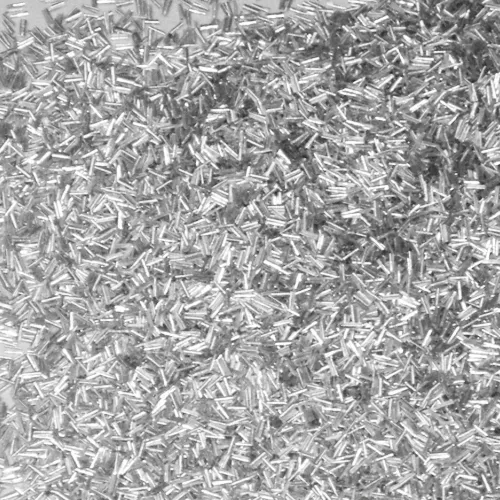
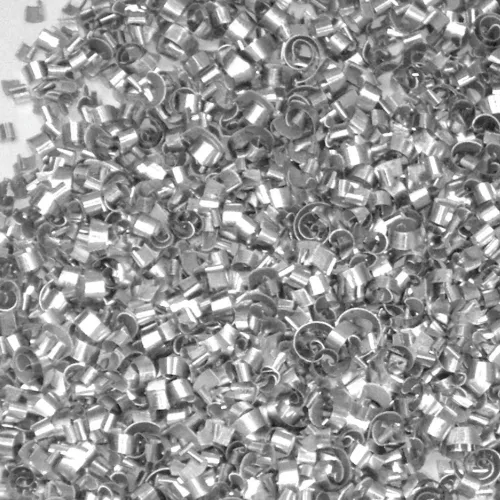
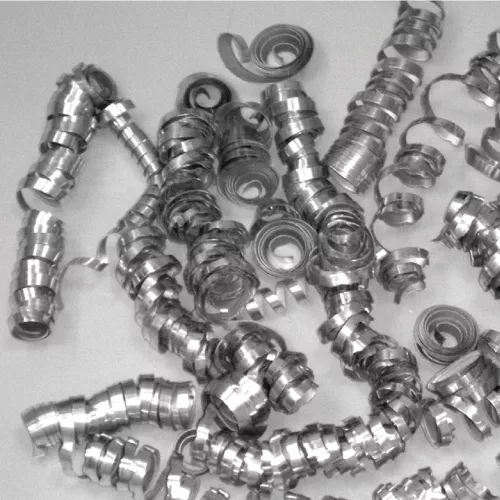
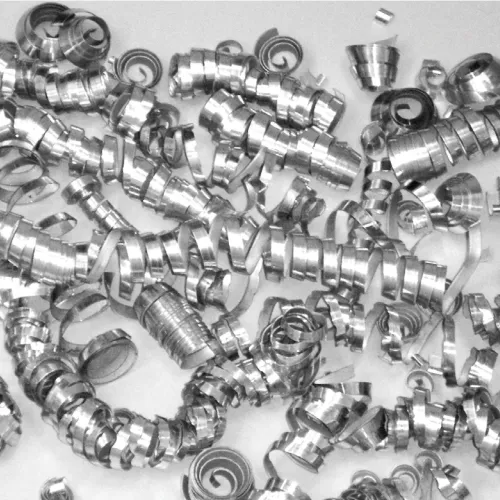
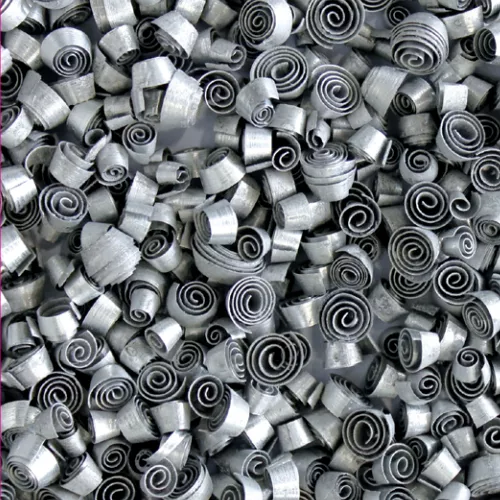
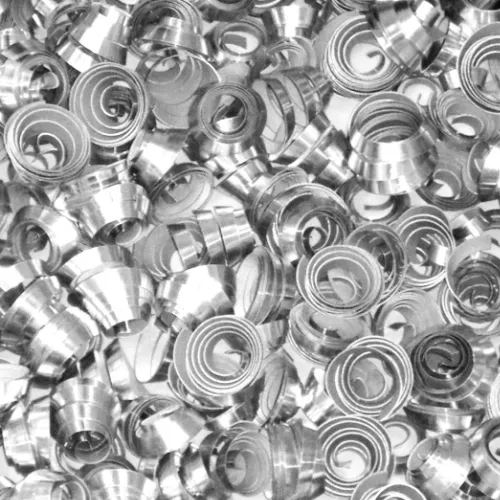
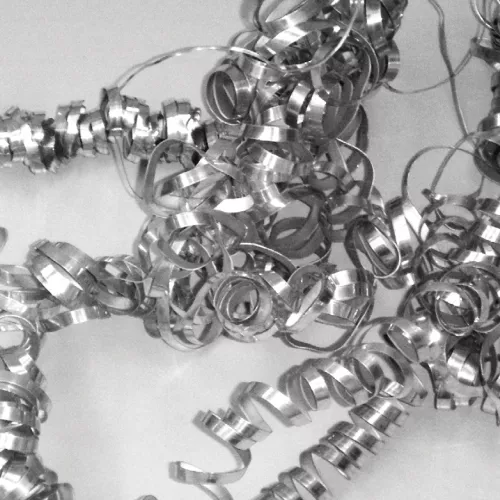

|
Designation |
Si |
Fe |
Cu |
Mn |
Mg |
Cr |
Ni |
Zn |
Ti |
Ga |
V |
Pb |
Others |
Others |
Total |
Al |
|
Individualemnte |
||||||||||||||||
|
2007 |
0,80 |
0,80 |
3,3-4,6 |
0,5-1,0 |
0,4-1,8 |
0,10 |
0,20 |
0,80 |
0,20 |
- |
- |
0,8-1,5 |
0,2 Bi; 0,2 Sn |
0,10 |
0,30 |
Rest |
|
2011 |
0,40 |
0,70 |
5,0-6,0 |
- |
- |
- |
- |
0,30 |
- |
- |
- |
0,2-0,6 |
0,2-0,6 Bi |
0,05 |
0,15 |
Rest |
|
2014A |
0,5-0,9 |
0,50 |
3,9-5,0 |
0,4-1,2 |
0,2-0,8 |
0,10 |
0,10 |
0,25 |
0,15 |
- |
- |
0,20 Zr+Ti |
0,05 |
0,15 |
Rest |
|
|
2017A |
0,2-0,8 |
0,70 |
3,5-4,5 |
0,4-1,0 |
0,4-1,0 |
0,10 |
- |
0,25 |
- |
- |
- |
- |
0,25 Zr+Ti |
0,05 |
0,15 |
Rest |
|
2024 |
0,50 |
0,50 |
3,8-4,9 |
0,3-0,9 |
1,2-1,8 |
0,10 |
- |
0,25 |
0,15 |
- |
- |
- |
- |
0,05 |
0,15 |
Rest |
|
2030 |
0,80 |
0,70 |
3,3-4,5 |
0,2-1,0 |
0,5-1,3 |
0,10 |
- |
0,50 |
0,20 |
- |
- |
0,8-1,5 |
0,20 Bi |
0,10 |
0,30 |
Rest |
|
5083 |
0,40 |
0,40 |
0,10 |
0,4-1,0 |
4,0-4,9 |
0,05-0,25 |
- |
0,25 |
0,15 |
- |
- |
- |
- |
0,05 |
0,15 |
Rest |
|
6026 |
0,6-1,4 |
0,70 |
0,2-0,5 |
0,2-1,0 |
0,6-1,2 |
0,30 |
- |
0,30 |
0,20 |
- |
- |
0,40 |
0,5-1,5 Bi |
- |
- |
Rest |
|
6060 |
0,3-0,6 |
0,1-0,3 |
0,10 |
0,10 |
0,35-0,6 |
0,05 |
- |
0,15 |
0,10 |
- |
- |
- |
- |
0,05 |
0,15 |
Rest |
|
6061 |
0,4-0,8 |
0,70 |
0,15-0,4 |
0,15 |
0,8-1,2 |
0,04-0,35 |
- |
0,25 |
0,15 |
- |
- |
- |
- |
0,05 |
0,15 |
Rest |
|
6063 |
0,2-0,6 |
0,35 |
0,10 |
0,10 |
0,45-0,9 |
0,10 |
- |
0,10 |
0,10 |
- |
- |
- |
- |
0,05 |
0,15 |
Rest |
|
6082 |
0,7-1,1 |
0,50 |
0,10 |
0,1-0,45 |
0,6-1,0 |
0,10 |
- |
0,20 |
0,15 |
- |
- |
- |
- |
0,05 |
0,15 |
Rest |
|
6101 |
0,3-0,7 |
0,50 |
0,10 |
0,03 |
0,35-0,8 |
0,03 |
- |
0,10 |
- |
- |
- |
- |
0,06 B |
0,03 |
0,10 |
Rest |
|
7075 |
0,40 |
0,50 |
1,2-2,0 |
0,30 |
2,1-2,9 |
0,18-0,28 |
- |
5,1-6,1 |
0,20 |
- |
- |
- |
0,25 Zr+Ti |
0,05 |
0,15 |
Rest |
Aluminium sheets
Alloys
1050
The alloys of the 1XXX series are characterised by very good corrosion resistance as well as good formability due to their lower mechanical properties.
2017
This alloy of the 2XXX series has a high mechanical strength as well as very good machinability due to its copper content. On the other hand, this element means that it does not have a high resistance to corrosion.
2024
Alloy of the 2XXX series with copper as the main alloying element. Very similar to the 2017 alloy, it has slightly higher mechanical characteristics. Not recommended for decorative anodising. Its main applications are in the field of aeronautics and defence.
3003
Manganese alloy mainly indicated for rolled semi-finished products especially suitable for drawing and forming. It does not maintain a good uniformity in anodised finish, so lacquering is more advisable. It has a great power of heat dissipation. Its main applications would be corrugated sheets for roofs and facades and corrugated bands for pipes, tanks and all types of roofs.
5005
Alloy of the 5XXX series with magnesium as the main alloying element. It has high corrosion resistance and is good for bending and welding. It is a suitable alloy for decorative anodising.
5052
Commercial alloy in the USA. Medium mechanical strength, high corrosion resistance especially for use in shipbuilding, easy forming and good weldability. This alloy may suffer from intercrystalline cracking and stress corrosion cracking after inadequate heat treatment (welding). Do not use above 65º if it is to be exposed to aggressive environments.
5083
Alloy with excellent corrosion behaviour with excellent mechanical properties and weldability. In the H321 state the resistance to intergranular corrosion is improved and in the H34 state the hardness is higher. This makes the products in these states ideal for marine and transport applications respectively.
5086
Structures and equipment: shipbuilding (welded components), masts, platforms. Chemical apparatus and storage tanks, cryogenics, piping and tubing. Automotive: welded tank trailers and welded rear hoppers. Railway: Sodulated tanks and structural components. Machinery: structures, apparatus, tools. Building and road construction, poles, towers, scaffolding. Transport: welded and welded storage tanks on cars.
5754
Alloy with excellent general corrosion behaviour and good cold formability with significantly lower mechanical properties than alloy 5083.
6082
Alloy possessing high mechanical properties and good corrosion resistance. It also has a good response to welding, although there is a loss of mechanical characteristics in the welded area, and it can be anodised without problems, provided that an aesthetic finish is not sought.
7075
It is one of the alloys with the highest mechanical characteristics and high fatigue strength. Its corrosion behaviour is not good, so protective anodising of the finished parts is recommended. Its main uses are in the field of aeronautics, defence, structural components as well as all types of components that require high resistance with low weight.
|
Designation |
Si |
Fe |
Cu |
Mn |
Mg |
Cr |
Ni |
Zn |
Ti |
Ga |
V |
Pb |
Other |
Total |
Al |
|
1050 |
0,25 |
0,4 |
0,05 |
0,5 |
0,5 |
- |
- |
0,07 |
0,05 |
- |
- |
- |
0,3 |
- |
Rest |
|
2017 |
0,20-0,80 |
0,7 |
3,5-4,5 |
0,4-1,00 |
0,4-1,00 |
0,10 |
- |
0,25 |
0,25 |
- |
- |
- |
0,05 |
0,15 |
Rest |
|
2014 |
0,50 |
0,5 |
3,80-4,90 |
0,30.0,90 |
1,20-1,80 |
0,10 |
0,25 |
0,20 |
- |
- |
- |
0,05 |
0,15 |
Rest |
|
|
3003 |
0,60 |
0,7 |
0,05-0,25 |
1,0-1,50 |
- |
- |
- |
0,10 |
- |
- |
- |
- |
0,15 |
0,15 |
Rest |
|
5005 |
0,25 |
0,7 |
0,2 |
0,2 |
0,50-1,10 |
0,10 |
- |
0,25 |
0,15 |
- |
- |
- |
0,05 |
0,15 |
Rest |
|
5052 |
0,25 |
0,4 |
0,10 |
0,10 |
2,20-2,80 |
0,15-0,35 |
- |
0,10 |
- |
- |
- |
- |
0,15 |
0,15 |
Rest |
|
5083 |
0,40 |
0,4 |
0,10 |
0,4-1,0 |
4,0-4,9 |
0,05-0,25 |
- |
0,25 |
0,15 |
- |
- |
- |
0,05 |
0,15 |
Rest |
|
5086 |
0,40 |
0,5 |
0,10 |
0,2-0,70 |
3,5-4,50 |
0,05-0,05 |
- |
0,25 |
- |
0,15 |
- |
- |
0,15 |
0,15 |
Rest |
|
5754 |
0,40 |
0,4 |
0,10 |
0,50 |
2,60-3,60 |
0,30 |
- |
0,20 |
- |
0,15 |
- |
- |
0,05 |
0,15 |
Rest |
|
6082 |
0,7-1,1 |
0,5 |
1,2-0,45 |
0,6-1,0 |
0,01 |
- |
0,20 |
- |
0,15 |
- |
- |
- |
0,05 |
0,15 |
Rest |
|
7075 |
0,40 |
0,5 |
1,2-2,0 |
0,30 |
2,1-2,9 |
0,18-0,28 |
- |
5,1-6,1 |
0,20 |
- |
- |
- |
0,05 |
0,15 |
Rest |
CAST AND MILLED PLATES (RECTIFIED)
Cast and milled aluminium plates are a product particularly suitable for the production of moulds, dies, tools... with low residual stresses that allow a better machinability. They are made of an alloy based on EN AW 5083. These plates have an excellent corrosion resistance and a very good machinability to which is added a good weldability and low stresses with good dimensional stability.
ALPLANTOK LAMINATED AND MILLED PLATES
Alplantok laminated and milled aluminium plates are a product particularly suitable for the production of templates, checking fixtures, reference plates,... with high dimensional stability. They are made of EN AW 5083 H111 alloy. These plates have excellent corrosion resistance and very good machinability, as well as good weldability and superior mechanical characteristics compared to cast plates.
Sectors
